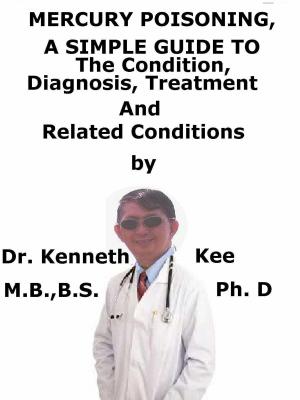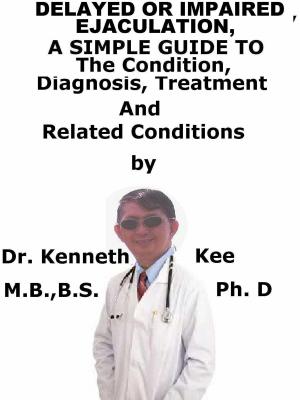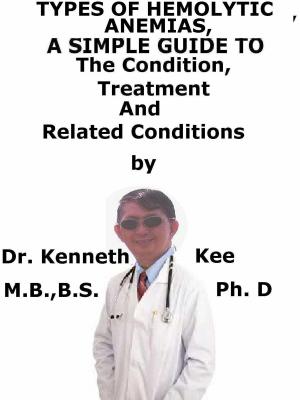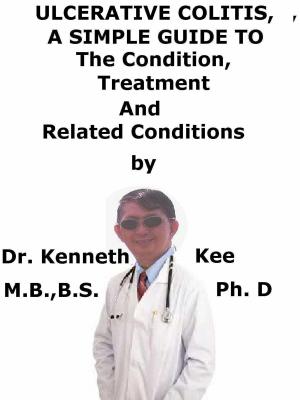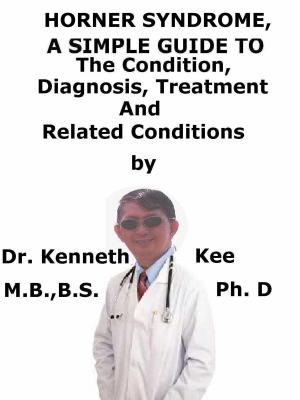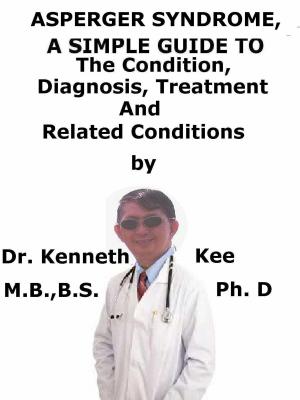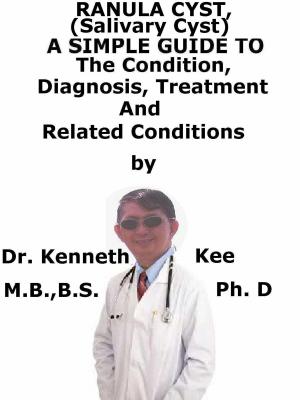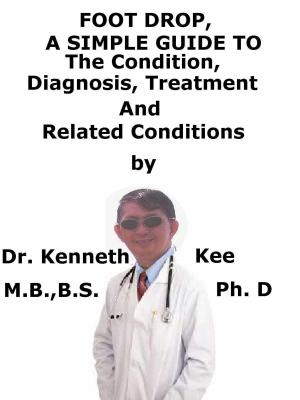Mycoplasma Infection, A Simple Guide To The Condition, Diagnosis, Treatment And Related Conditions
Nonfiction, Health & Well Being, Health, Ailments & Diseases, Respiratory, Medical, Infectious Diseases, General| Author: | Kenneth Kee | ISBN: | 9781370823918 |
| Publisher: | Kenneth Kee | Publication: | November 22, 2016 |
| Imprint: | Smashwords Edition | Language: | English |
| Author: | Kenneth Kee |
| ISBN: | 9781370823918 |
| Publisher: | Kenneth Kee |
| Publication: | November 22, 2016 |
| Imprint: | Smashwords Edition |
| Language: | English |
Mycoplasma infection is the medical respiratory illness caused by the bacteria Mycoplasma Pneumoniae.
This type of pneumonia is also called atypical pneumonia because the symptoms are different from those of pneumonia due to other common bacteria.
Mycoplasmal organisms normally grows on mucosal surfaces particularly extracellular surfaces of the respiratory and urogenital tracts.
They do not penetrate the submucosa except when the immune system of the body is very low when they may go into the bloodstream and spread to different organs and tissues all over the body.
It is often known as Walking Pneumonia as the symptoms are normally mild and most patients are able to function quite normally.
Hospitalization is seldom needed.
This bacterium is one of the bacteria that do not have cell walls.
Because of this, the bacterium is hard to destroy with common antibiotics such as penicillin which direct its action on the the cell wall synthesis.
Mycoplasma infections happen episodically throughout the year.
Frequent community episodes can also happen.
Symptoms normally start two to three weeks after exposure to the bacteria but can vary from one to four weeks.
The symptoms form gradually, over a period of two to four days.
Normal symptoms are fever, cough, bronchitis, sore throat, headache and tiredness.
Physical findings are:
1. Throat inflammation
2. Inflamed ear drum (tympanic membrane)
3. Conjunctivitis (red eyes)
4. Maculopapular or urticarial rash
5. Chest sounds in patients with pneumonia such as localized rhonchi and scattered moist crepitations affecting multiple lobes of the lung.
There may be rhonchi or wheezing sounds with no evidence of consolidation or bronchial breathing.
A frequent result of mycoplasma infection is pneumonia (occasionally called "walking pneumonia" because it is normally mild and rarely requires hospitalization).
Symptoms may continue for a few days to more than a month
Blood and sputum samples are taken and tested for evidence of mycoplasma
The test is best done one week after the start of symptoms.
Treatment of Mycoplasma is:
1. Lower the fever with aspirin, nonsteroidal anti-inflammatory drugs (NSAIDs, such as ibuprofen or naproxen), or acetaminophen. Do NOT give aspirin to children.
2. Avoid cough medicines without first discussing with the doctor.
Cough medicines may make it harder for the body to spit up the extra sputum.
3. Drink plenty of fluids to help soften mucus and bring up phlegm.
4. Get plenty of rest. Get someone else to do the household work.
5. Antibiotics are given to treat atypical pneumonia:
Oral erythromycin or one of the newer macrolides such as azithromycin or clarithromycin has always been the treatment of choice for mycoplasmal respiratory tract infections.
Tetracycline antibiotics and quinolones are also given.
Treatment with proper antibiotics should be given for 10 to 14 days
TABLE OF CONTENT
Introduction
Chapter 1 Mycoplasma Infection
Chapter 2 Causes
Chapter 3 Symptoms
Chapter 4 Diagnosis
Chapter 5 Treatment
Chapter 6 Prognosis
Chapter 7 Pneumonia
Chapter 8 Bronchitis
Epilogue
The other day a patient was asking me whether the mycoplasma bacterium is the smallest micro-organism on Earth and why it is so hard to treat.
It is the smallest bacterium presently known and is also smaller than a lot of viruses but there are viruses (retroviruses) that are smaller than Mycoplasma bacterium (0.15-0.3µm).
Mycoplasma bacteria do not have cell walls and can only be killed by stopping its multiplying.
Mycoplasma infection is the medical respiratory illness caused by the bacteria Mycoplasma Pneumoniae.
This type of pneumonia is also called atypical pneumonia because the symptoms are different from those of pneumonia due to other common bacteria.
Mycoplasmal organisms normally grows on mucosal surfaces particularly extracellular surfaces of the respiratory and urogenital tracts.
They do not penetrate the submucosa except when the immune system of the body is very low when they may go into the bloodstream and spread to different organs and tissues all over the body.
It is often known as Walking Pneumonia as the symptoms are normally mild and most patients are able to function quite normally.
Hospitalization is seldom needed.
This bacterium is one of the bacteria that do not have cell walls.
Because of this, the bacterium is hard to destroy with common antibiotics such as penicillin which direct its action on the the cell wall synthesis.
Mycoplasma infections happen episodically throughout the year.
Frequent community episodes can also happen.
Symptoms normally start two to three weeks after exposure to the bacteria but can vary from one to four weeks.
The symptoms form gradually, over a period of two to four days.
Normal symptoms are fever, cough, bronchitis, sore throat, headache and tiredness.
Physical findings are:
1. Throat inflammation
2. Inflamed ear drum (tympanic membrane)
3. Conjunctivitis (red eyes)
4. Maculopapular or urticarial rash
5. Chest sounds in patients with pneumonia such as localized rhonchi and scattered moist crepitations affecting multiple lobes of the lung.
There may be rhonchi or wheezing sounds with no evidence of consolidation or bronchial breathing.
A frequent result of mycoplasma infection is pneumonia (occasionally called "walking pneumonia" because it is normally mild and rarely requires hospitalization).
Symptoms may continue for a few days to more than a month
Blood and sputum samples are taken and tested for evidence of mycoplasma
The test is best done one week after the start of symptoms.
Treatment of Mycoplasma is:
1. Lower the fever with aspirin, nonsteroidal anti-inflammatory drugs (NSAIDs, such as ibuprofen or naproxen), or acetaminophen. Do NOT give aspirin to children.
2. Avoid cough medicines without first discussing with the doctor.
Cough medicines may make it harder for the body to spit up the extra sputum.
3. Drink plenty of fluids to help soften mucus and bring up phlegm.
4. Get plenty of rest. Get someone else to do the household work.
5. Antibiotics are given to treat atypical pneumonia:
Oral erythromycin or one of the newer macrolides such as azithromycin or clarithromycin has always been the treatment of choice for mycoplasmal respiratory tract infections.
Tetracycline antibiotics and quinolones are also given.
Treatment with proper antibiotics should be given for 10 to 14 days
TABLE OF CONTENT
Introduction
Chapter 1 Mycoplasma Infection
Chapter 2 Causes
Chapter 3 Symptoms
Chapter 4 Diagnosis
Chapter 5 Treatment
Chapter 6 Prognosis
Chapter 7 Pneumonia
Chapter 8 Bronchitis
Epilogue
The other day a patient was asking me whether the mycoplasma bacterium is the smallest micro-organism on Earth and why it is so hard to treat.
It is the smallest bacterium presently known and is also smaller than a lot of viruses but there are viruses (retroviruses) that are smaller than Mycoplasma bacterium (0.15-0.3µm).
Mycoplasma bacteria do not have cell walls and can only be killed by stopping its multiplying.

